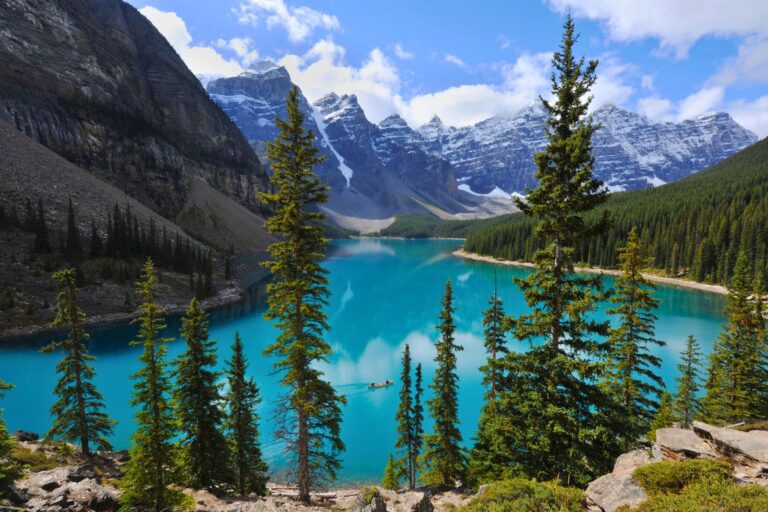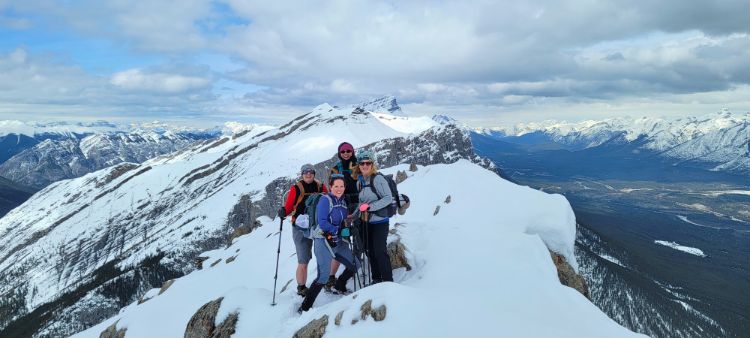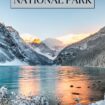
It would seem that no matter where you want to visit these days, if it’s outside, you can expect a crowd of people wanting to do the same. National Parks and popular recreation areas became targets for swarms of people as soon as social media made them mainstream.
No longer can you just see the pic, make the decision, and go, as you are likely to encounter limited access and ‘reservations required’ restrictions. Planning is necessary, at the very least, alongside a good heft of luck and purposeful decision-making.
One of the most beautiful areas that I’ve ever visited, which makes it ripe for hordes, is Banff National Park in Alberta, Canada. A year-round mecca for skiing, hiking, photography, and just general ‘looky-loos,’ the latest count had over 4 million people visiting the area in 2022/23, with those numbers steadily rising year over year. Considering the difficulty of getting to the area and the limited season for most who visit, that means an awful lot of people are packing into a very small outdoor space.
Having visited in all seasons, I’ve developed a plan of action to make the most of the area to make the best of my time in this outdoor wonderland. Here are some tips to navigate the wonders that make up Banff National Park.
1. Become Friends with the Banff National Park Website

As it seems to be with every single outdoor space that exists anymore, restrictions are becoming commonplace and making visits more challenging. Just showing up with a list of must-see places will lead to some heavy disappointment, as the parks service works to contain the problem of too many people in too small a space.
Recently Parks Canada shut down any personal vehicle travel to Moraine Lake; you now have to book a shuttle to see it. Lake Louise still offers parking but will now charge over $35 CAD daily to park. Construction often shuts areas down in the summer months, some parking lots fill up early, and rehab areas can be closed for maintenance. The best way to temper disappointment? Research.
Parks Canada is the official Banff website, which holds an overwhelming amount of information. Several Facebook visitor groups exist as well, but that can be almost TOO much info, causing an overload. The best place to start is on the official website, tailoring your visit to what you want to see and how much time you have available.
There are no shortage of options, no matter if you just want to drive and see some sights or if you want to hike off the beaten path, but it’s a big area. Curtailing your visit to the time available and most desired activities will at least provide a good starting place.
2. Consider the Shoulder Season

I am not a skier, so I can’t speak on behalf of those that would come to the Banff area to ski, but as a hiker, the shoulder season is very hit or miss. Traffic is certainly down, as are prices, but so is the access to certain areas. It is worth considering the in-between seasons if you are willing to give up some of the most heavily photographed higher elevation areas of the park.
Winter can hold off through October and even into November, keeping access and trails open and allowing for some serious larch-fused vistas. There’s no guarantee of that though, so it’s very possible winter could change your plans quickly. Moraine Lake, for example, which is maybe the most picturesque spot of them all, is supposed to be open until mid-October, but an early season snowstorm would change that. So while the number of visitors will be less, the risk is much higher.
Spring is the same. Snow will stay piled high well into July in the higher elevations, and spring hikes could mean mud, ice, snow, or a combination of all three. Prepare for anything, as that’s exactly what you could get.
The cheaper lodging and smaller crowds enticed us to take the chance twice this past late winter/early spring, and we were one for two. Our initial trip was shortened and spent largely indoors, as trails were closed due to avalanche risk and temps were too frigid to tolerate much outdoors at below zero. Our second trip was perfection, so the risk paid off, but one has to weigh the risk/reward factor. A wasted five-hour drive and a long weekend is far different than the cost of flights and precious vacation days if the risk doesn’t pay off.
But if you can, and if you’re willing to be daring, it can be well worth it. The stores are not as crowded, no wait to get into restaurants, and finding parking everywhere was a breeze. Trails can still be found with no worry about getting up early to find a parking space. The same can’t be said for the busy summer season when all of those things can be a nightmare.
3. Prepare for Summer Risks

That being said, summer can be risky as well. Wildfire smoke is bound to affect conditions at some point during the summer. My first trip to Banff, I managed to see all of the ‘must-see’ spots, however, I saw them through a shroud of thick smoke, and I do mean thick. It was mid-August, and we couldn’t even see many of the mountains that line the roadways. Imagine my surprise the next time I visited.
4. Be Willing to Skip the Hot Spots

If you were to google Banff, what you would immediately see is images of several of the most popular locations: Moraine Lake, Lake Louise, Peyto Lake to name a few. While these places are indeed magnificent, there is far more to be discovered and enjoyed.
These popular spots are where most of those Instagram photos are taken, so crowds gather with an intensity to catch those same pics. So if you want to capture those same shots, plan. Go early, book reservations as needed, know restrictions that might prevent or delay your arrival. But also…
Look outside of those popular stops. If you are a hiker, there is a seemingly infinite number of possibilities for all manner of hikes. Elevation gain, crystal clear lakes, tea houses, mountain peaks, there are options for all of these to be found, and by and large, anything that’s not just an easy walk is going to mean far fewer people. I have gone down many a rabbit hole, find one hike I think I want to do, notice another hike nearby and decide that’s an even better option. It’s never-ending.
I certainly wouldn’t suggest that if you are not a regular hiker you attempt a 12-mile hike up several thousand feet just to avoid crowds. Go with what you’re comfortable with to avoid a miserable rest of your vacation. But with the variety of hiking available, there is a little something doable for everyone. I took some friends to the Lake Agnes tea house, which was a short but steep four mile round trip adventure, busy but nothing like the shoreline along Lake Louise. It was a challenge enough, and the payoff was well worth it.
Shorter hikes will of course have bigger crowds, so whatever you decide to do, make it an early start. Johnston Canyon is a very popular place, which is mostly just a stroll through a waterfall-infested canyon, and if you try to show up after stopping for a leisurely breakfast, expect to have a hard time finding parking if you are allowed in at all. But, if you can manage it, there is a hike to the Ink Pots above the canyon that is minimally traveled and has huge payoffs: mountain views alongside quiet and respite from the massive crowds.
Best Accommodations Near Banff
5. Consider Jasper, Kootenay, Kananaskis or Yoho Too

Banff is the most well-known of the parks in this area, but not the only place in this part of the Canadian Rockies to enjoy. Driving into the Banff area across the Kootenay Highway has introduced me to enough potential hikes to keep me busy for most of a summer.
The Spray Lakes area below Canmore is another stunning location with incredible options for hikes, miles of them. One of my all-time favorite days on the trail was the short but steep hike to Ha Ling, a very short drive outside of town.
I would have known nothing about that trail had I not started looking at what the AllTrails App offers for hikes in various areas. Alltrails will also give you a great idea of latest trail conditions, invaluable when in the iffy off-season.
6. Stay Flexible and Enjoy!

With research and an awareness of what is available where, one can get a whole lot done in a little bit of time, but one can also waste a lot of time being under-prepared. Before you go, whatever your means, learn the area as well as you can, which will make a last-minute pivot far less intrusive and the time much more enjoyable.
Whatever time you go, prep yourself as best you can for any and all conditions. No shortage of magic exists in the Canadian Rockies, and one trip will likely not be nearly enough. Have options, make sound decisions, and bring your best-prepared self to take advantage of an unbelievable experience in the amazing Canadian Rockies.
Inspire your next adventure with our articles below:
Author Bio: Erica Pogel is an avid hiker in the Northwestern United States, spending time as a Physical Therapist Assistant in between hikes. She has lived and traveled throughout the United States and Internationally and is in constant pursuit of her next grand adventure. Follow along on Instagram.
Want to discover more hidden gems and helpful travel tips? Join our free newsletter for the latest travel secrets and travel articles.
We are reader-supported and may earn a commission on purchases made through links in this article.

